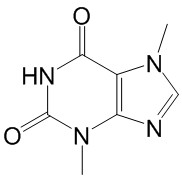Home
Products
Theobromine



| Product Name | Theobromine |
| Price: | $15 / 20mg |
| Catalog No.: | CN02162 |
| CAS No.: | 83-67-0 |
| Molecular Formula: | C7H8N4O2 |
| Molecular Weight: | 180.16 g/mol |
| Purity: | >=98% |
| Type of Compound: | Alkaloids |
| Physical Desc.: | Powder |
| Source: | The fruits of Theobroma cacao L. |
| Solvent: | Chloroform, Dichloromethane, Ethyl Acetate, DMSO, Acetone, etc. |
| SMILES: | Cn1cnc2c1c(=O)[nH]c(=O)n2C |
| Contact us | |
|---|---|
| First Name: | |
| Last Name: | |
| E-mail: | |
| Question: | |
| Description | Theobromine is a methylxanthine found in cacao beans which can inhibit adenosine receptor A1 (AR1) signaling. |
| Target | Human Endogenous Metabolite |
| In Vitro | Theobromine, at concentrations above 25 μM, decreases lipid accumulation in these cells. Cell viability is not affected by Theobromine. Theobromine, at concentrations above 25 μM, suppresses protein expression of PPARγ, C/EBPα and adipogenic genes. The mRNA levels of these genes are also decreased by Theobromine[1]. |
| In Vivo | Body weights are lower in the Theobromine group than in the vehicle group. In addition, Theobromine suppresses gains in weight of epididymal and perirenal adipose tissues. The mean adipocyte area is smaller in the Theobromine group than in the vehicle group[1]. Theobromine group shows lower counts than the other groups when considering the number of bacteria per fecal weight (p=0.021 and p=0.055 compare to the reference (RF) and the cocoa (CC) groups, respectively). The Theobromine diet leads to higher pH values than those found after the RF and CC diets. Fecal concentrations of lactic acid are not significantly affected by the experimental diets (4.26±1.54 mM in RF group; 1.96±0.41 mM in CC group; 2.69±0.73 mM in Theobromine group)[2]. |
| Animal Admin | Lewis rats (3 week old) are used in this study. The rats are randomly distributed into three dietary groups (n=7 per group): the reference (RF) group ingested standard diet AIN-93M, the cocoa (CC) group ingested a standard diet with 10% of natural Forastero cocoa containing 0.25% Theobromine, and the Theobromine (TB) group ingested a standard diet including 0.25% of Theobromine, i.e. the content of Theobromine presents in the CC diet[2]. |
| Density | 1.6±0.1 g/cm3 |
| Boiling Point | 495.5±37.0 °C at 760 mmHg |
| Flash Point | 253.5±26.5 °C |
| Exact Mass | 180.064728 |
| PSA | 72.68000 |
| LogP | -2.08 |
| Vapour Pressure | 0.0±1.3 mmHg at 25°C |
| Storage condition | Refrigerator |